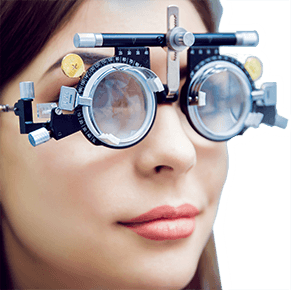Ortho-K and corneal refractive therapy: Overnight contacts to correct myopia

Wouldn't it be great if you could correct your eyesight and reduce your dependence on glasses or contact lenses — without having to undergo eye surgery?
It might sound far-fetched, but it's a reality for many people. It's called orthokeratology, or ortho-k.
Here are the top 10 things you should know about orthokeratology:
1. What is ortho-k?
Orthokeratology (ortho-k) is the fitting of specially designed gas permeable contact lenses that you wear overnight. While you are asleep, the lenses gently reshape the front surface of your eye (cornea) so you can see clearly the following day after you remove the lenses when you wake up.
Ortho-k lenses are prescribed for two purposes:
To correct refractive errors (primarily short sightedness, but also astigmatism and hyperopia). In some cases, ortho-k also is used to correct presbyopia.
To slow the progression of childhood myopia.
Ortho-k lenses are also called "corneal reshaping contact lenses" or "overnight contact lenses to correct or control myopia."
One specific brand of ortho-k lenses and fitting technique is Bausch+Lomb's Vision Shaping Treatment (VST). But ortho-k can be safely and successfully performed with other gas permeable (GP) lenses and corneal reshaping fitting techniques.
Only highly "breathable" GP lenses that have been approved for overnight wear should be used for orthokeratology.
2. What is corneal refractive therapy (CRT)?
Paragon CRT (Paragon Vision Sciences) is a specific brand of corneal reshaping lenses that has a proprietary lens design and fitting methodology, called corneal refractive therapy (CRT). Though technically different than orthokeratology, CRT is used for similar purposes and produces comparable results.
For simplicity, I'll be using the terms "orthokeratology" and "ortho-k" to describe all types of corneal reshaping lenses — including corneal refractive therapy lenses — in this article. Your optician will determine which type of corneal reshaping lenses are best for you after examining your eyes.
3. How long does the ortho-k effect last?
You should be able to see acceptably well without glasses or contact lenses for a day or two, sometimes longer. For best results, you should wear the ortho-k lenses every night.
4. Which vision problems can ortho-k correct?
Orthokeratology is most frequently used to temporarily correct myopia (short sightedness). Generally, ortho-k can correct upwards of -6.00 diopters (D) of myopia.
Ortho-k can also correct lesser degrees of astigmatism, hyperopia and presbyopia.
The type and amount of refractive error that can be effectively managed with orthokeratology differ on a case-by-case basis. Your optician will be able to give you more specific guidance after examining your eyes.
5. Who is a good candidate for orthokeratology?
Most people with mild to moderate myopia (with or without mild astigmatism) are good candidates for ortho-k.
Because the corneal reshaping effect is temporary, little risk is involved, and you can discontinue wearing the lenses at any time — provided you are willing to start wearing glasses or contacts again when your myopia returns!
Children and young adults who want to be glasses-free but are too young for LASIK or are not good candidates for refractive surgery for other reasons (dry eyes, for example) often are good candidates for ortho-k. People who participate in contact sports or work in dusty environments that can pose problems for contact lens wear may also be good candidates.
6. Who fits ortho-k lenses?
It is important to know that orthokeratology is a very specialised type of contact lens fitting, and not all opticians who fit contact lenses also fit ortho-k lenses. If orthokeratology interests you, seek the services of an optician who specialises in fitting these lenses.
7. What results can you expect from ortho-k?
Opticians usually aim for 20/20 vision (6/6 in the UK) after ortho-k, but 20/40 vision (the legal minimum for driving in most of the United States) often is considered an acceptable outcome.
In the FDA clinical study for approval of Paragon CRT lenses, 93% of patients achieved 20/32 vision or better, and 67% achieved 20/20 or better. In the clinical study for FDA approval of one VST design, about 95% achieved 20/40 or better, and 73% achieved 20/20 or better. Both studies followed patients for at least nine months.
8. What to expect when you begin ortho-k
The optician will begin by measuring the curvatures of your corneas using an instrument called a corneal topographer — a painless procedure that takes about a minute and produces a topographical map of your eye's surface.
Your optician might use an in-practice inventory of lenses for fitting your eyes with ortho-k lenses the same day corneal topography measurements are taken, or he or she may order custom ortho-k lenses for fitting at a later date.
You may need a series of temporary lenses to see properly until you reach the desired prescription. In most cases, up to three pairs of lenses are required to achieve the maximum vision correction effect.
When you begin to wear ortho-k lenses, you are likely to have some awareness of the lenses on your eyes until you fall asleep. With time, the lenses typically become more comfortable immediately upon insertion.
9. How long does it take for maximum ortho-k effect?
This depends on many factors, especially the amount of short sightedness (and possibly astigmatism) you have when you begin the ortho-k process.
Some people can have excellent vision after a day or two of overnight ortho-k. But for higher prescriptions, it can take two weeks or longer for maximum correction.
Until your eyes are fully corrected, you might notice blurred vision and glare and halos around lights. In some cases, you may need to wear glasses (with a lesser prescription than you originally had) during the ortho-k process. Also, in some cases, mild glare and halos might persist even after maximum ortho-k correction.
10. How much does ortho-k cost?
Fitting ortho-k lenses is a more time-consuming process and requires more expertise than fitting regular contact lenses. It requires a series of practice visits and potentially multiple sets of lenses.
Each optician determines his or her own fees for orthokeratology, based in part on their level of expertise, time required and lens costs.
The cost of ortho-k, including follow-up care associated with fitting the lenses, can vary significantly depending on the type and degree of your refractive error and whether you are choosing ortho-k lenses for long-term myopia control in addition to the temporary correction of existing myopia.
Costs can also vary based on the region of the country, urban vs. rural settings, and the type of practice where you have the procedure performed.
Ortho-k prices in the UK generally range from £700 to £1500 (for both eyes), making the procedure roughly half the cost of LASIK. But particularly difficult cases of ortho-k can cost as much as £3,000.
There are additional costs for replacement ortho-k lenses, lens care solutions and follow-up exams, which can total about £200 to £400 per year.
Normally, orthokeratology is not covered completely by vision care insurance plans, but a portion of the fees may be covered by some plans.
Bonus Q&A: Can I have LASIK after ortho-k?
Yes, it's possible to have LASIK after ortho-k if you later desire vision surgery to permanently correct your eyesight.
Unlike LASIK, ortho-k is reversible. If you try reshaping lenses and later decide you want laser eye surgery instead, you can do that.
But you will have to discontinue wearing the lenses and wait a period of time before surgery (possibly several months) to allow your corneas to fully revert to their pre-orthokeratology shape.
Finally, keep in mind that, as with all contact lenses, there are some possible side effects and complications of wearing ortho-k lenses. Ask your optician for details.
READ MORE: Contact lens types and materials
Wave ortho-k designs approved for overnight wear through B+L VST program. Contact Lenses Today.February 2012.
Page published on Monday, 8 June 2020






